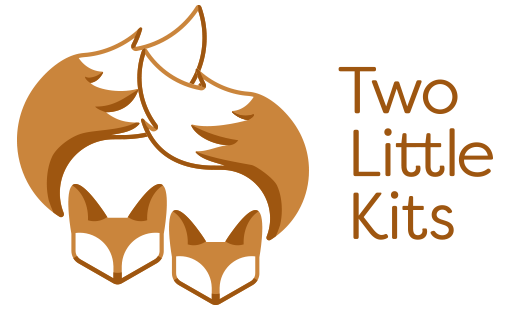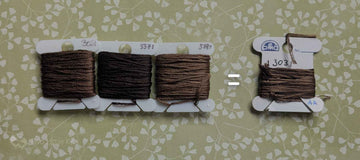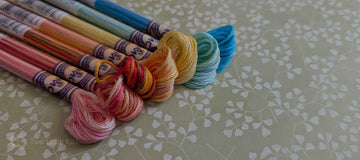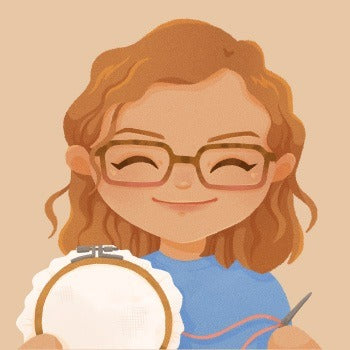Typography in Cross-Stitch: A Beginner-Friendly Guide to Fonts, Letters, and Stitchy Design
Typography might sound like one of those fancy design terms reserved for graphic designers or people who spend hours picking fonts in Google Docs or Microsoft Word (guilty!), but it’s actually something we all interact with every single day—and yes, even in the world of cross-stitch.
Whether you’re stitching a sassy quote, a heartfelt family name, or a few poetic lines that speak to your soul, the way your words look is just as important as what they say. And that, dear stitchy friend, is where typography comes in.
So let’s take a fun and beginner-friendly stroll through the basics of fonts and lettering, and how they apply to cross-stitch and backstitch patterns—especially if you’re keen to design your own or modify an alphabet to suit your style.
What Is Typography Anyway?
Typography is the art of arranging letters in a way that makes text both readable and beautiful. In printed or digital form, it’s all about font choice, size, spacing, and how those elements come together to tell a story or set a mood.
In cross-stitch, we do the same thing—with needle and thread. The words we stitch take on a whole new personality depending on the alphabet style we use, how bold or dainty it is, and even how big or small we make it on our fabric.
If you're new to working with fonts in your projects, my cross-stitch [and backstitch] alphabets are a great place to begin!

The Big Three: Ascenders, Descenders, and X-Height
These might sound like spell names from a fantasy novel, but they’re just parts of letters that give a font its shape and rhythm.
- Ascenders are the tall parts of lowercase letters that stick up above the middle line—think b, d, h, l.
- Descenders are the parts that hang down below the line—like p, q, y, g.
- X-Height is how tall the lowercase letters are on average—like the height of the letter x. A font with a larger x-height often looks chunkier and is easier to read at small sizes.
All of the alphabets in my font collection are created with this balance in mind, to help your message stay crisp and readable.

In cross-stitch: These features matter a lot! If your ascenders and descenders don’t have enough space to breathe, the letters might end up looking squished or unbalanced when stitched. A well-designed alphabet will account for this spacing so that every letter has room to shine.
Serif vs Sans-Serif: Picking a Font Vibe
One of the simplest font categories is serif vs sans-serif. It’s a great way to think about how a font feels.
- Serif fonts have those little flicks or “feet” at the ends of letters (like Times New Roman). They often feel classic, elegant, or traditional.
- Sans-serif fonts are clean and modern, without those little decorative ends (like Arial). They tend to feel casual, friendly, or minimal.
In cross-stitch: Serif fonts can be trickier to stitch cleanly, especially at smaller sizes, because those tiny feet need precise placement. Sans-serif fonts are usually easier for beginners and work beautifully for modern designs. You can find both serif and sans-serif options in my alphabet pattern range so you can pick the right fit for your design.
Size, Boldness & Stitchy Emotion
Typography isn’t just about structure—it’s also a big part of how we feel when we look at text. Want something loud and confident? Go bold! Want something delicate and sweet? Try thin lettering with soft curves.
In cross-stitch: You can play with the scale and boldness of a font to match the mood of your piece. A thick, blocky font stitched in bright red might scream "LOOK AT ME!"—perfect for a funny quote. A thin script stitched in pastel might whisper a gentle message of comfort

Choosing an Alphabet for Your Cross-Stitch Project
When buying or downloading a cross-stitch or backstitch alphabet to DIY your own message—whether it’s a family name, a wedding date, a quote, or something totally unique—here are a few tips to help you out:
- Check the readability. Letters should be easy to tell apart. If the r and n start to look like an m, keep browsing!
- Mind the spacing. Some alphabets come with suggested spacing or kerning (that’s the space between letters). That can really help beginners make it look neat.
- Make sure you get upper and lowercase. Some alphabets only provide one or the other. Double-check you have what you need for your specific phrase.
- Consider the vibe. Think about the feeling you want the words to convey, and let that guide your font choice.
- Use graph paper or software. When laying out your words, it's super helpful to use graph paper or a digital cross-stitch design app to test the look before you stitch.
My backstitch-friendly alphabets are especially useful for creating delicate, handwritten-style pieces and are beginner-friendly for layout tweaks!
Want to Design Your Own Cross-Stitch Font?
Feeling brave? Designing your own alphabet can be an incredibly satisfying creative challenge. Here are a few beginner tips to get you started:
- Start with a few letters you use a lot (like A, E, S, M).
- Use a consistent width and height across all your characters.
- Pay attention to ascenders, descenders, and x-height for balance.
- Try sketching on graph paper first—each square = one stitch.
- Use backstitch for more delicate fonts and cross-stitch for chunkier ones.
It doesn’t have to be perfect—just you. And once you’ve stitched your own alphabet in a design? It feels pretty amazing, not gonna lie.

Ready to Stitch Your Words?
Typography adds a powerful layer to your cross-stitch projects. Whether you’re using a pre-made alphabet or designing your own from scratch, understanding these basic concepts can help you make your text more readable, expressive, and downright beautiful.
If you're feeling inspired to play with lettering, you might also enjoy checking out my embroidery stitches how-to series or browsing my hand embroidery and cross-stitch patterns for more creative ideas.
Let your words shine—one stitch at a time. ✨

Leading image: Stock photo by Raphael Schaller via Unsplash.
It shows old-school typesetting blocks, which were used for printing.



![FlossTube #97 - A Big [Stitching] Catch-Up Was Necessary](http://twolittlekits.com/cdn/shop/articles/250407-banner-flosstube_b48399ff-c283-4a4b-9e57-bc02ca0ea2ff.jpg?v=1745268230&width=360)





